ARCHIVED - Canadian Human Rights Tribunal
 This page has been archived.
This page has been archived.
Archived Content
Information identified as archived on the Web is for reference, research or recordkeeping purposes. It has not been altered or updated after the date of archiving. Web pages that are archived on the Web are not subject to the Government of Canada Web Standards. As per the Communications Policy of the Government of Canada, you can request alternate formats on the "Contact Us" page.
2010-11
Report on Plans and Priorities
Canadian Human Rights Tribunal
The original version was signed by
The Honourable Robert Douglas Nicholson
Minister of Justice and Attorney General of Canada
Table of Contents
- Raison d'être and Responsibilities
- Strategic Outcome
- Program Activity Architecture
- Planning Summary
- Contribution of Priorities to Strategic Outcome
- Risk Analysis
- Expenditure Profile
- Voted and Statutory Items
Section II – Analysis of Program Activities by Strategic Outcome
- Strategic Outcome
- Program Activity: Hearings of Complaints before the Tribunal
- Program Activity: Internal Services
Section III – Supplementary Information
Chairperson's Message
Canadians have built a diverse society and are proud of the progress they have made in transforming the ideals of equality and inclusion into cultural norms. Yet true equality remains an ongoing and often elusive goal. The Canadian Human Rights Tribunal is an integral part of the federal government infrastructure created to achieve that goal.
The Canadian Human Rights Tribunal is the administrative body that hears complaints of discrimination arising throughout the federally regulated sphere. It hears from complainants and respondents alike, as well as from interested third parties, including the Canadian Human Rights Commission. Through open, fair and transparent hearings, the Tribunal assesses evidence and rules on complaints of discrimination. The Tribunal's decisions inform the parties—and Canadians—about the law as applicable to specific facts that arise in complaints. By guaranteeing open, fair and transparent hearings and by providing just and well-reasoned rulings on individual complaints of discrimination, the Tribunal helps to entrench equality into the daily lives of Canadians. Thus, the Tribunal gives real effect to these lofty ideals through practical and legally binding decisions.
For the Tribunal, a new planning cycle invariably offers a renewed opportunity to seek out process improvements and refinements in all aspects of its management and operations, and 2010–2011 is no exception. The pages that follow chronicle our plans to provide ever better value to the Canadian public through ongoing improvements to many aspects of our administration. In my role as the new Chairperson of this Tribunal, I will continue to search for innovative ways to provide an effective and efficient process that allows parties to access justice in a timely fashion as we move ahead toward achieving an ideal society based on diversity, equality and fairness.
Shirish P. Chotalia, Q.C. LL.M.
Section I – Tribunal Overview
Raison d'être and Responsibilities
Raison d'être
The Canadian Human Rights Tribunal is a quasi-judicial body that hears complaints of discrimination referred by the Canadian Human Rights Commission and determines whether the activities complained of violate the Canadian Human Rights Act (CHRA). The purpose of the CHRA is to protect individuals from discrimination and to promote equal opportunity. The Tribunal also decides cases brought under the Employment Equity Act (EEA) and, pursuant to section 11 of the CHRA, determines allegations of wage disparity between men and women doing work of equal value in the same establishment.
Roles and Responsibilities
In hearing complaints under the CHRA and the EEA, the Canadian Human Rights Tribunal considers matters concerning employment or the provision of goods, services, facilities or accommodation. The CHRA makes it an offence for a federally regulated employer or service provider to discriminate against an individual or group on any of the following grounds:
- race;
- national or ethnic origin;
- colour;
- religion;
- age;
- sex (includes pay equity, pregnancy, childbirth and harassment, although harassment can apply to all grounds);
- marital status;
- family status;
- sexual orientation;
- disability (can be mental or physical, and includes disfigurement and past, existing or perceived alcohol or drug dependence); or
- conviction for which a pardon has been granted.
The Tribunal's jurisdiction covers matters that come within the legislative authority of the Parliament of Canada, including those concerning federal government departments and agencies, as well as banks, airlines and other federally regulated employers and providers of goods, services, facilities and accommodation. The Tribunal holds public hearings to inquire into complaints of discrimination. Based on evidence and the law (often conflicting and complex), it determines whether discrimination has occurred. If it makes a finding of discrimination, the Tribunal determines the appropriate remedy to compensate the victim of the discriminatory practice, as well as policy adjustments necessary to prevent future discrimination.
The majority of discriminatory acts that the Tribunal adjudicates are not malicious. Many conflicts arise from long-standing practices, legitimate concerns of employers, or conflicting interpretations of statutes and precedents. The role of the Tribunal is to discern the positions of the parties and establish fair and appropriate rules to resolve the dispute.
The Tribunal may inquire only into complaints under the CHRA that are referred to it by the Canadian Human Rights Commission, usually after a full investigation by the Commission. The Commission resolves most cases without the Tribunal's intervention. Cases referred to the Tribunal generally involve complicated legal issues, new human rights issues, unexplored areas of discrimination or multi-faceted evidentiary complaints that must be heard under oath, especially in cases with conflicting evidence that involve issues of credibility.
The Tribunal is not an advocate for the CHRA; that is the role of the Commission. The Tribunal has a statutory mandate to apply the Act based solely on the evidence presented and on current case law. If there is no evidence to support an allegation, then the Tribunal must dismiss the complaint.
The Tribunal reports to Parliament through the Minister of Justice.
The Tribunal does not participate in any initiatives for Canada's Economic Action Plan.
Organizational Structure
The Canadian Human Rights Tribunal is a small, permanent organization comprising a full-time Chairperson and Vice-Chairperson, and up to 13 full- or part-time members (see chart). Under the CHRA, both the Chairperson and the Vice-Chairperson must have been members of the bar for more than 10 years.
Tribunal Organization Chart
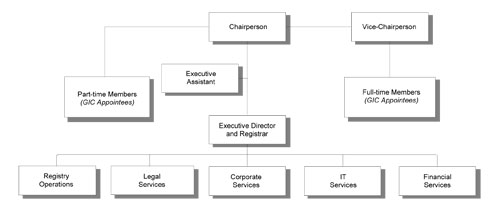
Members
To be eligible for appointment by the Governor in Council, Tribunal members must have experience, expertise, interest in and sensitivity to human rights. Terms of office are up to five years for full- and part-time members, and up to seven years for the Chairperson and Vice-Chairperson. Throughout their terms, Tribunal members take training and attend briefing sessions on such topics as decision-writing techniques, evidence and procedure, and in-depth analysis of human rights issues.
Registry Operations
Administrative responsibility for the Tribunal rests with the Registry. It plans and arranges hearings, acts as liaison between the parties and Tribunal members, and provides administrative support. The Registry is also accountable for the operating resources that Parliament allocates to the Tribunal.
Internal Services
Internal Services are activities and resources that support the needs of the Tribunal's operating program and other corporate obligations. They include corporate, legal, financial, human resources, information management and information technology services. Human resources services are supplemented through a contractual agreement with Public Works and Government Services Canada.
Strategic Outcome
The Tribunal seeks to achieve the following strategic outcome:
Individuals have equal access, as determined by the Canadian Human Rights Act and the Employment Equity Act, to fair and equitable adjudication of human rights and employment equity cases that are brought before the Canadian Human Rights Tribunal.
Program Activity Architecture
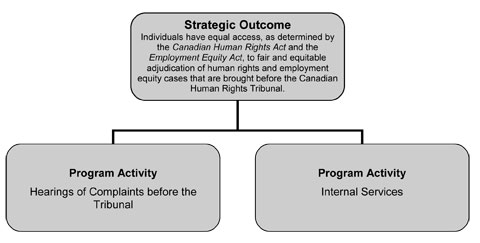
Planning Summary
| 2010–2011 | 2011–2012 | 2012–2013 |
|---|---|---|
| 4.5 | 4.5 | 4.5 |
| 2010–2011 | 2011–2012 | 2012–2013 |
|---|---|---|
| 26 | 26 | 26 |
Planning Summary Table ($ millions)
| Performance Indicator | Targets |
|---|---|
| Tribunal decisions/rulings | Rendering decisions within four months of the close of the hearing in 80% of cases |
| Program Activity1 | Forecast Spending 2009–2010 |
Planned Spending | Alignment to Government of Canada Outcomes | ||
|---|---|---|---|---|---|
| 2010–2011 | 2012–2012 | 2012–2013 | |||
| Hearings of Complaints before the Tribunal | 2.5 | 2.6 | 2.6 | 2.6 | Social Affairs The Tribunal's singular program, to conduct inquiries into complaints of discrimination in accordance with the CHRA, is a legislatively designed alignment with the government's Social Affairs outcome, creating a diverse society that promotes linguistic duality and social inclusion. |
| Internal Services | 1.9 | 1.9 | 1.9 | 1.9 | |
| Total Planned Spending | 4.5 | 4.5 | 4.5 | ||
1 For program activity descriptions, please access the Main Estimates.
Contribution of Priorities to Strategic Outcome
Given its sole strategic outcome, its single program activity and the fairly stable context in which the Tribunal operates, Tribunal priorities tend to remain relatively unchanged from year to year. In the Tribunal's ongoing effort to provide individuals with equal access to fair and equitable adjudication of human rights and employment equity cases, Tribunal members will provide well-reasoned decisions and, where appropriate, order suitable remedies for those who have suffered discrimination. As necessary, Tribunal decisions will also provide guidance and direction to employers and service providers on the development of policies and practices that are consistent with respecting human rights. In addition to its usual business of conducting hearings, the Tribunal plans to pursue the priorities summarized in the table below. (Please note that all Tribunal activities are linked to its single strategic outcome, so the table identifies only links to program activities.)
| Operational Priorities | Type | Links to Program Activities | Description |
|---|---|---|---|
| Continuous program improvement | Ongoing | Hearings of Complaints before the Tribunal | The Tribunal will continue to strive for increased efficiency in its inquiry process to better meet the demand for expeditiousness articulated in the Canadian Human Rights Act. |
| Management Priorities | Type | Links to Program Activities | Description |
|---|---|---|---|
| Strengthen corporate management capacity | Ongoing | Hearings of Complaints before the Tribunal Internal Services |
The Tribunal will continue to research, develop and implement corporate and administrative efficiencies that will best support and enable an efficient and expeditious complaint inquiry process, as required by the Canadian Human Rights Act. |
| Strengthen information management and information technology capacity | New | Hearings of Complaints before the Tribunal Internal Services |
The Tribunal will continue to research, develop and implement technology-related efficiencies that will best support and enable an efficient and expeditious complaint inquiry process. |
Risk Analysis
Micro-agencies such as the Tribunal typically struggle to keep up with their larger counterparts in implementing government-wide modernization initiatives. Among the initiatives that have taken a significant toll on Tribunal resources are its ongoing efforts to strengthen information management capacity, reinforce information technology security, deliver on internal audit implementation and develop measures for enhancing corporate management in the context of public service renewal.
Another source of uncertainty for Tribunal operations is the unpredictable nature of the Tribunal's workload. As illustrated in the following bar graph, the Canadian Human Rights Commission referred an average of 44 cases a year between 1996 and 2002. Referrals increased dramatically during 2003 and 2004 and, although the number of cases referred eased somewhat through 2005 and 2006, the Tribunal's caseload resumed its upward trend in 2008, with 103 new cases. The final case volume for 2009 was 80, as of December 16, 2009.
Number of Cases per Year (1996 to 2009)
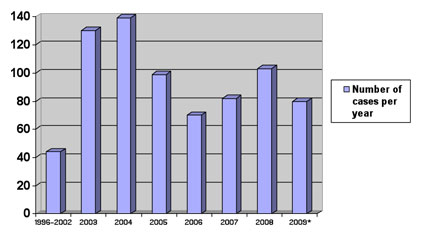
* Number of cases for 2009 was the amount as of December 16, 2009.
Another factor that could affect Tribunal operations in the year ahead would be appointments of new members—delays in filling vacant positions could create a case backlog and increase the length of time to render a decision. Despite its very limited resources, the Tribunal plans to continue meeting these challenges over the next three fiscal years using a combination of operational and corporate strategies. To ensure the continuity of in-house expertise for addressing the workload risk, the Tribunal is focusing on human resources retention, knowledge transfer and succession planning.
The Tribunal will also continue to embrace new technologies and interdepartmental partnerships to ensure that resource-intensive horizontal obligations do not undermine its ability to carry out its mandate.
Expenditure Profile
Funding
The Tribunal is funded by annual appropriations from Parliament through a program expenditure vote for hearings and administrative operating expenditures. Main reference levels are not usually sufficient to cover costs for cases requiring inordinately long hearings, such as cases to determine allegations of wage disparity between men and women doing work of equal value in the same establishment (i.e., pay equity cases); Treasury Board submissions are prepared as required to obtain additional funding for cases of such magnitude.
Spending Trend
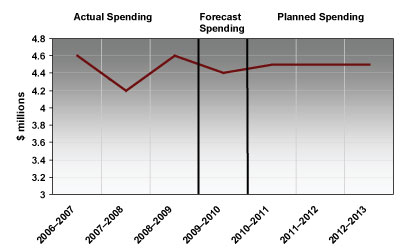
Spending trends have remained relatively constant over time. Amounts shown in this report do not include services provided without charge by other government departments and agencies—approximately $1.2 million per year for accommodation provided by Public Works and Government Services Canada and for government payments to employee insurance plans provided by Treasury Board Secretariat. At the time this document was prepared, it was forecast that the annual appropriation amount for 2009–2010 would be spent. The majority of expenses are for salaries and benefits, conducting hearings, and maintaining the internal services that provide the infrastructure that supports the Tribunal's single program.
2010–2011 Planned Spending by Program Activity
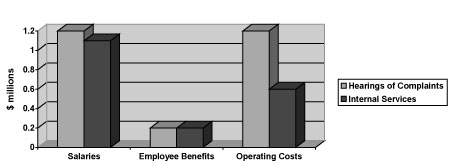
| Vote # or Statutory Item (S) | Truncated Vote or Statutory Wording | 2009–2010 Main Estimates |
2010–2011 Main Estimates |
|---|---|---|---|
| 15 | Program expenditures | 4.0 | 4.1 |
| (S) | Contributions to employee benefit plans | 0.4 | 0.4 |
| TOTAL TRIBUNAL | 4.4 | 4.5 | |
Section II – Analysis of Program Activities by Strategic Outcome
Strategic Outcome
Individuals have equal access, as determined by the Canadian Human Rights Act and the Employment Equity Act, to fair and equitable adjudication of human rights and employment equity cases that are brought before the Canadian Human Rights Tribunal.
The Tribunal achieves its strategic outcome and results for Canadians through its main program activity, Hearings of Complaints before the Tribunal, together with its Internal Services program activity.
| Human Resources (FTEs) and Planned Spending ($ millions) | |||||
|---|---|---|---|---|---|
| 2010–2011 | 2011–2012 | 2012–2013 | |||
| FTEs | Planned Spending | FTEs | Planned Spending | FTEs | Planned Spending |
| 13 | 2.6 | 13 | 2.6 | 13 | 2.6 |
| Program Activity Expected Results | Performance Indicators | Targets |
|---|---|---|
|
|
|
Program Activity Summary
The Tribunal inquires into complaints of discrimination to decide, following a hearing before Tribunal members, if particular practices have contravened the Canadian Human Rights Act. Tribunal members also conduct hearings into applications from the Canadian Human Rights Commission and requests from employers to adjudicate on decisions and directions given by the Commission under the Employment Equity Act.
Planning Higlights
To achieve the expected result, the Tribunal plans to pursue the following priority:
Continuous Program Improvement
| Planned Activity | Result and Time Line |
|---|---|
| Monitor the Tribunal's case management initiative for effectiveness and efficiency | Measures that appropriately assess the timeliness, effectiveness and efficiency of the Tribunal's inquiry process by March 2011 |
Human rights complaints raise very serious issues that affect Canadian society directly and have the potential to affect the livelihood and key business operations of those who come before the Tribunal. The Tribunal therefore strives to commence hearings of complaints within 6 months of referral by the Commission and strives to conclude inquiries within 12 months of referral. However, many of the human rights cases before the Tribunal raise factual and legal issues of such complexity and importance that a rush to hearing is neither feasible nor desirable. Complaints sometimes also arise in settings that pose logistical difficulties, such as remote northern communities, or in situations where the pressures of an expedited adjudication process pose a particular challenge. Since the 2005 introduction of case management, hearings have been unfolding more efficiently. The Tribunal nevertheless recognizes that parties sometimes need more time and the additional intervention of a Tribunal member to not only get to hearing but also to ensure the hearing itself does not become protracted.
The Tribunal will continue to examine and monitor case management procedures to maximize the effectiveness and efficiency of this process. It will also introduce added flexibility into the process to help parties resolve the complaint or get to hearing within the earliest possible time frame, for example, to allow for earlier intervention by a Tribunal member in cases where it is evident that the parties could benefit from mediation. It will also investigate the practicality of implementing best practices adopted for use in other fora, such as the appropriate use of witness statements and affidavit evidence at hearings, to replace evidence presented in person before the Tribunal.
Benefits for Canadians
As the custodian of a vital piece of Canada's human rights protection machinery, the Tribunal benefits Canadians by enhancing the texture and quality of the fabric of Canadian society. It gives effect to the principles enshrined in federal human rights legislation by providing a forum where human rights complaints can be scrutinized and resolved. Its formal decisions articulate findings and observations on important issues of discrimination. The result of the Tribunal's program is that complainants can air their grievances and achieve closure in a respectful, impartial forum. In the longer term, Tribunal decisions create meaningful legal precedents for use by employers, service providers and Canadians.
Although the Tribunal (including its predecessors) has been part of the human rights landscape in Canada for decades, Tribunal decisions have not always enjoyed the authority they do today. Until recently, allegations of institutional bias and lack of independence undermined the Tribunal's effectiveness, and often gave rise to requests for judicial reviews of Tribunal decisions and rulings. In fact, all eight of the Tribunal's written decisions issued in 1998 were challenged. Statutory changes that same year raised the stature and perceived independence of the Tribunal, resulting in fewer challenges to Tribunal decisions and greater approbation by the Federal Court when Tribunal decisions are appealed. Complainants and respondents both benefit from Tribunal decisions being perceived as definitive—the parties can get on with their lives.
Written decisions become part of the public record. As well as specifying whether a respondent's actions have run afoul of the Act, Tribunal decisions provide guidance, where appropriate, on how to bring policies and practices into line with the legislation to prevent discrimination in future. Such explanations benefit not only the parties involved, but also all employers and service providers and their employees and clients. It is therefore an expected (and sought after) result of Tribunal decisions that they will be accepted by the parties involved and, if judicially challenged, upheld by the reviewing court. Such acceptance ultimately benefits all of society since it expedites justice and reduces the cost of protracted appeals.
| Human Resources (FTEs) and Planned Spending ($ millions) | |||||
|---|---|---|---|---|---|
| 2010–2011 | 2011–2012 | 2012–2013 | |||
| FTEs | Planned Spending | FTEs | Planned Spending | FTEs | Planned Spending |
| 13 | 1.9 | 13 | 1.9 | 13 | 1.9 |
| Program Activity Summary and Planning Highlights |
|---|
Internal Services are groups of related activities and resources that support the needs of programs and other corporate obligations of the Tribunal. These groups are: acquisition services; communications services; financial management services; human resources management services; information technology services; legal services; management and oversight services; materiel services; real property services; and travel and other corporate services. Internal Services include only those activities and resources that apply across the organization and not those provided specifically to a program. The Tribunal will continue to research, develop and implement corporate and administrative efficiencies that will best support and enable an efficient and expeditious complaint inquiry process. The Tribunal has a sound results-oriented framework based on its Management Accountability Framework (MAF) that takes into account the best interests of the agency, members, employees and Canadians. The planning highlights focus on an integrated management approach that covers areas ranging from human resources, risk management, performance measurement, modern technology and comptrollership. To contribute to efforts for a green, energy-conscious government and to reduce the effect of Tribunal activities on the environment, the Tribunal will also investigate and implement new technologies wherever possible for improving management practices and reducing waste. As a micro-agency, the Tribunal harbours no illusions about its limited capacity to shape the broader federal public service. It will nevertheless continue to seek out every opportunity to work with and contribute to other government departments and agencies, especially those of like size and mandate, to assist in meeting the government-wide challenge for public service renewal. |
To achieve the managerial priority of improved corporate management, the Tribunal plans to undertake the following activities:
- strengthen the Tribunal's corporate management capacity; and
- strengthen the Tribunal's information management and information technology capacity.
Strengthen the Tribunal's Corporate Management Capacity
| Planned Activity | Result and Time Line |
|---|---|
| Enhance the Tribunal's management policies and practices to optimize their effectiveness in supporting the Tribunal's mandate and the government's public service renewal initiative | An action plan in response to the Treasury Board Management Accountability Framework assessment (Round VII) of the Tribunal's management practices by March 2011 |
The Tribunal is a micro-agency (26 FTEs). Although challenged on a much smaller scale than larger federal government organizations, the Tribunal nevertheless faces a similar need to continually strengthen its strategic corporate management to ensure it remains relevant, accountable, results-focused, effective and competitive within the context of a respected, professional and forward-looking public service.
The Tribunal will continue to monitor and strengthen its management practices and policies to ensure their adequacy in meeting the Tribunal's priorities.
The MAF sets Treasury Board's expectations for modern public service management. The framework helps to reinforce sound management and provides managers with a model for management and for management improvement through the use of indicators and measures that evaluate organizations' performance in various areas of management. The Tribunal was included in Round VII of the MAF assessment conducted by Treasury Board Secretariat. The Tribunal will analyze the assessment results, expected in fall 2010, and develop an action plan to address areas requiring improvement.
Strengthen the Tribunal's Information Management and Information Technology Capacity
| Planned Activity | Result and Time Line |
|---|---|
| Enhance the Tribunal's information management (IM) and information technology (IT) capacity by consolidating approaches to IM/IT and optimizing available technology resources |
|
Managing information efficiently, effectively and safely is a crucial part of the Tribunal's responsibilities for aligning with the government's Framework for the Management of Information. The Tribunal has strengthened its information holding capacity by implementing the Records, Document and Information Management System (RDIMS) in 2006. An RDIMS software upgrade is planned for completion by end of 2010–2011.
In 2009–2010 the Tribunal also began developing an IM strategy. In 2010–2011 the Tribunal will begin implementing the various elements identified in the strategy by introducing a communications plan, a governance structure and an accountability matrix. The Tribunal will also work closely with Library and Archives Canada to implement the new Directive on Recordkeeping issued in June 2009 by Treasury Board Secretariat.
The Tribunal uses an automated product called the Tribunal Toolkit to manage its operational case files. In 2009–2010 the Tribunal began investigating an upgrade to its case management system. The project seeks to deliver additional integration, collaboration, monitoring, reporting and business functionalities that will help the Tribunal optimize available technology resources.
The Tribunal continues to progress in its compliance with the government's Management of IT Security Standard. In response to those requirements, the Tribunal implemented an IT security policy and a business continuity plan. In 2010–2011 the Tribunal plans to act on the recommendation of its 2009–2010 internal security audit to develop and implement a strategic IT plan.
Section III – Supplementary Information
Financial Highlights
The Tribunal does not have any financial highlights.
List of Supplementary Information Tables
There are no supplementary tables.
Other Items of Interest
Contacts for Further Information and Website
Executive Director and Registrar
Canadian Human Rights Tribunal
160 Elgin Street
11th Floor
Ottawa, Ontario
K1A 1J4
Tel: 613-995-1707
Fax: 613-995-3484
E-mail: registrar@chrt-tcdp.gc.ca
Website: www.chrt-tcdp.gc.ca
Legislation and Associated Regulations Administered
The Minister of Justice is responsible to Parliament for the Canadian Human Rights Act (R.S. 1985, c. H-6, as amended).
The Minister of Labour is responsible to Parliament for the Employment Equity Act (S.C. 1995, c. 44, as amended).
Statutory Annual Reports and Other Tribunal Reports
The following documents can be found on the Tribunal's website: